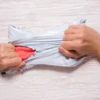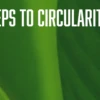What can fashion learn from cycling?
Hello, Nicole here from The Renewal Workshop! I’ve just got back from an unusual kind of holiday: I spent a week training to be a bike mechanic! I’ll admit it may seem a strange way to use my free time, but I was pleasantly surprised to discover just how optimized the bike world is for circularity. And fashion has a lot to learn…
It’s perhaps not surprising that circularity is almost built into the cycling industry. After all, part of a bike’s appeal is how long it works after you buy it. So, it makes sense that there’s a lot of effort put into making sure that your bike is easily serviceable and that it’s simple to replace parts and recycle them when they wear out.
But why is the cycling world so much more circularity-ready than the fashion industry? Bikes are designed for functionality, more than for looks. Rather than being created to mimic a specific trend, the primary driver in bike design is ensuring a smooth ride. And at the end of the day that comes down to addressing pain points.
Whether it’s tube sealant to avoid punctures, ergonomic seats to make long rides more comfortable, or a mounted basket to carry home heavy loads of shopping, bikes are precision-engineered to keep users riding for as long as possible, as comfortably as possible. And part of that is ensuring all bike parts are replaceable or serviceable.
The fashion industry, in its current state, has a whole different set of drivers. The key for many companies is getting as many of the latest styles produced as possible. There is very little incentive, currently, to design clothing to be repairable or easy to disassemble. That’s why we need a fundamental change of mindset.
We need a fashion industry that behaves a lot more like the cycling industry, with products that are not just designed for looks but for durability, repairability, and ease of disassembly. And there’s no doubt that this will require a huge mindset shift around how we view clothing: it’s time we got back to valuing our garments for their durability.
Restoring the value of clothes
Achieving circularity is only possible if we can first address the root of the problem: consumers currently view clothes as disposable. But how can we change this perception? We’re constantly bombarded with marketing messages, influencers and targeted advertising encouraging us to buy new, buy more, and buy now.
People repair bikes because they view them as worth repairing. So, what we need is a fashion industry that restores the value of clothes by treating them like valuable assets. But before people will treat clothes as valuable, they need to understand that they are worth repairing. Take the example of a pair of jeans.
If the zipper of your jeans broke, many would be tempted to throw them out, even though 99 per cent of the garment is still in good working order. That’s the equivalent of chucking away a whole bike just because you get a flat tire — ridiculous! The problem is that most people don’t know how to address even simple problems with clothing.
And an even bigger problem is that they’re not motivated to find ways to address them because those ways just don’t exist yet at a large enough scale in the fashion industry. With bikes, on the other hand, people either know how to fix the problem themselves or know where to go to get it fixed. In fashion, it’s just not the case.
That means a fundamental job of the circular economy for fashion is to give consumers ways to repair or renew their clothes. Because once consumers start seeing garments as repairable, their perceived value increases. A key barrier to overcome, therefore, is the effort barrier.
We need to make it easier and more attractive to repair or renew clothing than to simply buy new. Because the sad truth is that in most cases it’s simply easier to click “buy now” than to look around for a good repair service, ship your jeans out to them, and wait for them to be returned. This is where brands have a big opportunity.
A circular economy for fashion has the potential to address the consumer pain point of falling-apart garments by providing clothing that is both more durable (so it won’t fall apart or break in the first place) and more repairable (so, if it breaks, there’s a simple, convenient fix). This is the first step to increasing garments’ perceived value.
Circular should be easy
We must build a fashion industry where it’s as easy or easier to renew and repair than to buy new. Once consumers start seeing the circular economy as a tool to help them overcome pain points like broken zippers, they will start thinking of clothing as more like a repairable, serviceable asset that you don’t just discard at the first sign of wear.
But to make this work, we need a two-way collaboration: more brands stepping up to supply circular solutions, and more consumers willing to buy into them. Of course, the two are interlinked. That’s because, in the circular economy, it’s the role of brands to sell the benefits that circularity can bring consumers.
Luckily, there’s nothing fashion brands do better than selling a lifestyle. Only in this case, that lifestyle is circularity. But to make this work, you need to know exactly which circularity models will work the best for your company right now. And to do that you must precisely identify your consumers’ pain points. Ready to get started?
Defining your circular business personality
In my last blog, I discussed how companies in the fashion space have been adopting different combinations of circular business models to increase the sustainability of their offerings. This time, we’ll go into more detail about how a circular business personality can supercharge your approach to creating more responsible fashion.
Below, we explore how some visionary circular fashion CEOs have changed perceptions around their products, using circular business models to address specific consumer pain points. These leaders are experts at shifting mindsets and selling the benefits of circular because they know their audience incredibly well.
What I’ve found during my time working with CEOs of sustainable fashion brands large and small is that they already have their ideal circularity strategy in mind. It’s often just a case of helping them take that first step with the tools and solutions that we have. This allows them to advance knowing they have the audience on their side.
That’s why we created a series of business archetypes to help brands position themselves within the circularity ecosystem. They consider factors such as your product price point, your positioning and your audience. Once we’ve decided which archetype fits your brand, we tailor our solutions to ensure it works with your strategy.
For instance, a mid-size luxury brand that’s already using organic cotton in its products would be ideally placed to set up a reselling platform thanks to the quality of its clothes. But a start-up that’s operating a rental-only model might decide to add recycling for end-of-life clothing to live up to the expectations of its fans.
Let’s look at a couple of real-life examples of brands that have leaned into their circular business personalities to address their consumers’ pain points:
Self-starter: MUD Jeans
We hear a lot about how damaging jeans are to the environment: thousands of litres of water. Tonnes of toxic dyes. Pesticide-intensive cotton. For environmentally conscious consumers, it feels bad to buy a normal pair knowing how much they cost the planet. That’s the pain point that Netherlands-based MUD Jeans identified.
And they found an innovative circular solution to address it. One of the world’s first certified B Corps, MUD Jeans pioneered an innovative denim “leasing” model for its organic cotton jeans — challenging traditional ideas of ownership to promote greater circularity for what was previously a highly polluting item of clothing.
And fans have been flocking to try it. Renting a pair of MUD Jeans entitles you to free repairs for life, even once the “lease period” has expired. And once your jeans have reached the end of their usable life, you can return them directly to one of their processing centres, where the team will recycle them into a new pair of jeans.
That means MUD Jeans isn’t just making their jeans with more sustainable materials — and designing them to be easily disassembled for recycling — they’re also encouraging users to view the jeans as a long-term investment rather than a one-off purchase. So, if the zipper breaks, you’re much less likely to throw them away.
That’s because MUD Jeans has turned the circular route into the path of least resistance. Since the cost of unlimited repairs is already included in the leasing price of the garment, it’s completely illogical for a consumer to throw the jeans away if all they need is a simple repair that they can easily access, for “free”.
This move effectively switches the perception of the garment from “accessory” to “tool” – meaning that consumers will place greater value on each item of clothing, so they’ll be much more likely to get them repaired or renewed. They’re treating clothes like an asset again, in the same way that we treat our bike as an asset.
This unique “closed-loop” system provides customers with a circular vision to buy into, addressing consumer demand for brands that enable more sustainable lifestyles[i]. By taking control of the entire garment life cycle in this way, MUD Jeans is reinventing our relationship with clothing, integrating circularity as a key behaviour.
It’s an excellent example of how a brand’s circularity model can be as integral to its appeal as the products themselves. And we can expect to see more such innovative brands coming onto the scene in the future. Often, to demonstrate how circularity can make a positive difference in consumers’ lives, you need to change perceptions.
Self-starters like MUD Jeans have circularity integrated into their DNA from the word go. Their entire business model and positioning are based on their circularity, and they have a highly engaged consumer base who are actively looking for products and services that will help them live more sustainable lives while buying less stuff.
Circularity has huge potential to create deep customer loyalty, involving consumers in the process of decarbonizing the fashion ecosystem like never before. By embodying circular values at every consumer touchpoint, MUD Jeans is creating a loyal fanbase that will keep coming back for more of its stylish and circular offerings.
Agile pivoter: Coyuchi
Many of us will know that sinking feeling you get when you open your linen closet and see a pile of sheets and towels that you don’t use anymore but that you can’t bring yourself to throw out. This is the pain point that Coyuchi addressed with its resale and repair platform, Coyuchi 2nd Home™️.
Coyuchi is an environmentally conscious bedding, lifestyle and apparel company. When they launched in 1991, they were among the first home textiles players to create their products with 100% organic cotton. But before they could integrate more circularity into their business model, there was a perception barrier to overcome.
At first, not everyone was sure how consumers would react to being sold pre-owned bed linen and household textiles. The key to overcoming this attitude was identifying the pain point that adopting circularity could address: the guilt that consumers felt at seeing their closets overflowing with unused sheets and towels.
This was the insight that Coyuchi needed to “flip the switch” and turn consumers on to the benefits of circularity. They were offering a way to remove that “linen-closet guilt” we mentioned before. Now, instead of feeling guilty and powerless, consumers could take action and send their household textiles to be turned into new products.
Another key factor in convincing consumers was communicating effectively about the renewal process itself. 2nd Home™️ products are laundered using the same ultra-hygienic methods that hotels use to wash their sheets – and educating consumers about this helped to make the idea of pre-owned linen much more accessible.
And with a discount voucher to sweeten the deal, it’s a great example of how solving effectively for a consumer pain point can make circularity the path of least resistance. The truth is often that your audience is hungry for these solutions, you’ve just got to provide them in a form that makes sense logically, ecologically, and financially.
Coyuchi 2nd Home™️ is proof that renewed products can be just as attractive as new — and in fact even more so! What’s key to their strategy is that it helps the consumer feel involved in the process of circularity: you can take positive action, so you feel like you’re “part of the solution”– helping make a more sustainable future for the planet.
That’s something money can’t buy. In many ways, the warm feeling of “buying better for the planet”, and alleviating environmental guilt, is as valuable as the quality of the goods you produce. In this way, circularity offers a whole new value stream: emotional value. And it can be an ideal way to amplify brand.
Renewal is also a great way to engage younger consumers. Coyuchi is a luxury linen brand, and 2nd Home allows you to access their products at a more affordable price point. So, it creates a whole new revenue stream and a new way to reach a prized younger demographic that would otherwise have been inaccessible to you.
Is your brand ready to explore circularity? It may just be time to find the “pivot point” that helps catapult you into the circularity ecosystem. And The Renewal Workshop is here to help. What specific pain point can you help people overcome through circularity? We’ll help you comb through the detail to find out.
Every time we help find a brand’s circular pivot point and clarify the best way to make circular the path of least resistance, we come one step closer to building a circular economy for fashion and textiles. Of course, sometimes you’ll face pushback, but it takes vision and ingenuity to counter the naysayers and forge ahead regardless.
That’s why we need visionary CEOs who are 100 per cent behind fashion circularity to drive the change we all need and create a more responsible industry. So, if you’re ready to take the reins and become a circularity innovator, there’s never been a better time.
Why not contact The Renewal Workshop for a free consultation and discover your circular business personality? We’ll discuss your circular ambitions and how we can help you reach them.
[i] Pope, R. (2021) Recent study reveals more than a third of global consumers are willing to pay more for sustainability as demand grows for environmentally-friendly alternatives (2021). Business Wire. Available at: https://www.businesswire.com/news/home/20211014005090/en/Recent-Study-Reveals-More-Than-a-Third-of-Global-Consumers-Are-Willing-to-Pay-More-for-Sustainability-as-Demand-Grows-for-Environmentally-Friendly-Alternatives














